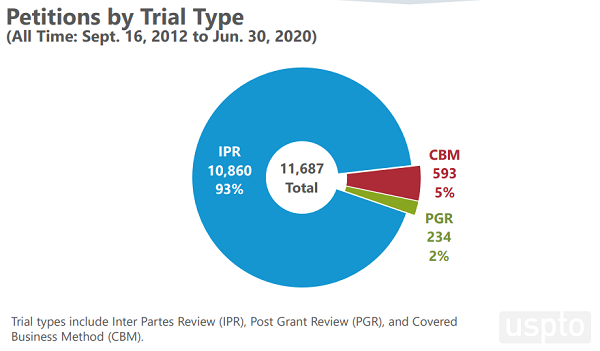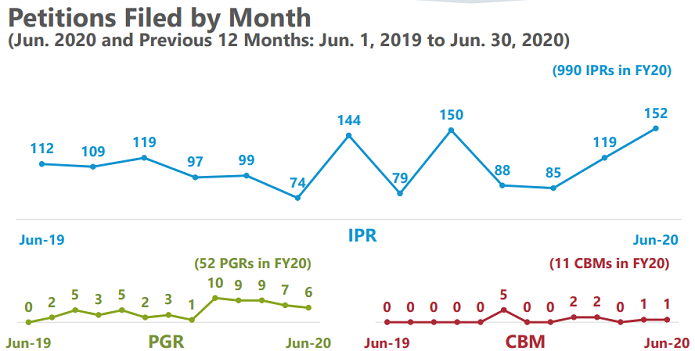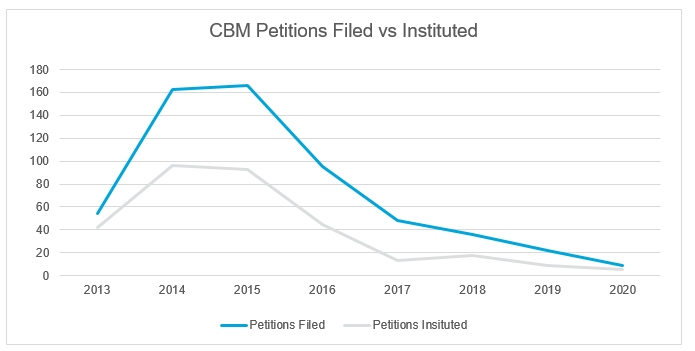
Covered Business Method (“CBM”) review ends in mid-September, and you have one last chance to take advantage.
In 2011,1 the AIA introduced three new administrative review proceedings of patentability with the goal of allowing parties to quickly and efficiently root out bad patents. The AIA applied a sunset period to CBM review, unlike other AIA proceedings, and the clock is quickly approaching zero (September 15, 2020).2 That means you have one last chance to leverage the benefits of CBM review.
If you are defending against an infringement suit based on a patent that covers financial services or products, and the patent’s claims are not grounded in a “technological innovation,” now may be the time to leverage CBM review—especially if you believe that the patent is invalid under §101 or other grounds not allowed in Inter Partes Review (“IPR”).
Scope of CBM
CBM reviews are limited. The only patents eligible for CBM review are patents (1) with claims directed at the practice, administration or management of a financial product or service, and (2) that do not claim a “technological invention.”3 However, if a patent is eligible for CBM review, then many of the limitations of the more broadly applicable IPR, and to some extent even Post-Grant Review (“PGR”), do not apply.
The types of patents that are eligible for CBM review have narrowed over time, resulting in today’s very narrow scope. This is, in part, because the AIA did not provide a clear rule defining “technological invention” and the United States Patent and Trademark Office (“USPTO”) left it to the Federal Circuit to set the bounds of CBM review.4 While the Federal Circuit lamented the USPTO’s failure to elaborate on the meaning of “technological invention” at first, the Federal Circuit also did not set bounds for CBM review by giving “technological invention” a clear definition.5 Rather, initially, the Federal Circuit only held that the use of prior art technology or an obvious combination of prior art technology would not amount to a “technological invention.”6 However, Federal Circuit decisions slowly chipped away at the scope of CBM review through various examples and gradually removed different types of patents from CBM review eligibility.7
Now, near the sunset of CBM reviews, the USPTO’s application of the Federal Circuit’s guidance has left the scope of eligible patents very narrow and limited, even though CBM review provides a number of advantages over other AIA proceedings.
Advantages of CBM
CBM reviews provide a number of benefits over the other review procedures, particularly over IPRs. These benefits include no time limit on when a CBM review can be filed, the grounds on which it can be based, the standard for institution, and the estoppel effect of CBM review.
| CBM | IPR | PGR | |
|---|---|---|---|
| Availability |
Must be sued or charged with infringement of the patent No time bar Cannot be filed if patent is eligible for PGR review |
Petition must be filed within one year of the petitioner or someone in privity therewith being sued If first-to-file, then cannot be filed if eligible for PGR |
From patent grant to nine months after patent grant or reissue |
| Grounds | 35 U.S.C. §§ 101, 102, 103 and 112, and double patenting | 35 U.S.C. §§ 102 and 103, but prior art is limited to patents and printed publications | 35 U.S.C. §§ 101, 102, 103 and 112, and double patenting |
| Standard for Institution | More likely than not | Reasonable likelihood of success | More likely than not |
| District Court Estoppel | Grounds that the petitioner actually raised during the CBM review | Grounds that were raised or reasonably could have been raised during the IPR | Grounds that were raised or reasonably could have been raised during the IPR |
Despite these advantages, CBM review has seen extraordinarily limited use. The USPTO’s statics tell of a dying program with little use. CBMs account for only five percent of all AIA challenges.
(Source: USPTO)
CBM review numbers have been even lower in recent times. For example, from June 2019 to June 2020, only 11 CBM petitions were filed. That is fewer than the number of PGRs filed in just June and May of 2020 and barely more than ten percent of the IPR petitions filed in June 2020.
(Source: USPTO)
There may be several reasons for the low use of CBM reviews. First, fewer patents are eligible for CBM review than IPRs. The test for determining whether a patent is eligible for CBM review is ambiguous and subject to the discretion of the USPTO and, to some extent, the Federal Circuit. An ambiguous, shifting test was not necessarily guaranteed to lead to the decline of CBM we witnessed. However, the USPTO’s application of the test has gradually eroded the scope of CBM review. As a result, most CBM review petitions were instituted in the first year of the program, but the institution rate dropped over the next few years even as use of CBM review grew. As petitioners realized this, the number of petitions filed declined dramatically.
(Data gathered from LexMachina)
Conclusion
The profoundly low number of new petitions is not a reason to discount the power of CBM review and its benefits over other AIA proceedings.
If you are facing an infringement suit regarding financial services or products, you should evaluate whether the patent underlying those allegations may be ripe for CBM review. CBM allows a far broader range of invalidity challenges, including those under §101, and does not have the IPR’s one-year time bar. In addition, CBM review opens the door to validity challenges beyond the scope of other AIA proceedings, while still presenting a faster and lower cost alternative to traditional litigation.
We do not know whether Congress will revive CBM review or replace it with another proceeding. Now is the time if you wish to take final advantage of CBM review.
1 President Obama signed the America Invents Act (“AIA”) into law on September 16, 2011 and outlined the new administrative review proceedings. However, the AIA did not take effect until September 16, 2012.
2 §18(a)(3) of the America Invents Act, Pub. L. No. 112-29, 125 Stat. 284 (2011) (petitions filed prior to this date will proceed as normal).
3 See 37 C.F.R. 42.301(a).
4 Versata Dev. Group, Inc. v. SAP Am., Inc., 793 F.3d 1306, 1325 (Fed. Cir. 2015).
5 See id at 1325-1327.
6 See id.
7 See, e.g., Unwired Planet, LLC, v. Google Inc., 841 F.3d 1376 (Fed. Cir. 2016) (holding that “a novel light bulb that is found to work particularly well in bank vaults does not become a CBM patent” and that merely disclosing financial aspects in the specification is not enough if those aspects are not tied to the claims).
This publication is provided for your convenience and does not constitute legal advice. This publication is protected by copyright.
© 2020 White & Case LLP



